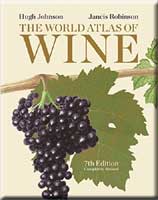The 15 June 2011 Wine Spectator featured an article on the Loire valley by James Molesworth. The basic thrust was that the rather good vintages from 2006 through 2008 have been followed by two great vintages in 2009 and 2010. If you are looking for fresh and light wines that depend more on acidity than oakiness with minerality and reasonable prices, this is the area to investigate. The Loire River begins appropriately enough in Haute-Loire about 400 miles south of Paris. It flows north-northwest reaching Orleans about 100 miles south of Paris where it turns east, flowing about 200 miles to Nantes where it meets the sea. This last section contains most of the fine chateaux and vineyards that most people envision when one mentions the Loire. However, shortly before this stretch one finds Sancerre on the east bank with Pouilly-Fumé across the river, two of the better, and better-known Loire Valley wines.
Unfortunately, although Molesworth speaks well of Sancerre and Pouilly-Fumé, saying 26 of the 43 wines sampled scored 90 or higher, there are few outstanding values. He notes Domaine Fouassier Sancerre Sur Le Fort ($23), Pascal Jolivet Sancerre Clos du Roy ($36), and the Régis Minet Pouilly-Fumé Vielles Vignes. All are from the 2009 vintage and scored above 90. He then mentions that better deals can be found in nearby Quincy, Reuilly, and Menetou-Salon, picking Domaine des Victoires Quincy ($19), Domaine de Reuilly Les Pierres Plates ($19), and Domaine Chatenoy Menetou-Salon ($22). All rated 88. These wines are all made from the Sauvignon Blanc grape, although Sancerre does make some red wine.
Downstream, the Touraine region surrounds Tours and the Vouvray region. He mentions a very affordable ($12) Les Vignerons de Coteaux Romanais Sauvignon Touraine Domaine du Haut Morlu. As one heads west through this area the Sauvignon Blanc changes over to Chenin Blanc. Vouvray makes some wines worth laying down for a few years (Clos de Nouys Vouvray Sec and offerings from Marc Brédif, Vincent Carême, Benoit Gautier, and Vigneau-Chevreau). Further to the west, the Melon de Bourgogne grape gives Muscadet its crisp, mineral taste, making it a perfect foil for seafood. The S&M area on the map is not the home of the Marquis de Sade, but Muscadet de Sèvre et Maine, a better region of Muscadet located between the Sèvre and Maine rivers. The Marquis' home is in southern France. The best red wines are made from the Cabernet Franc grape in the Touraine region with Chinon, Bourgueil, and Saumur or Saumur-Champigny standing out. Look for Jean-Maurice Raffault Chinon Les Galuches ($16) and the Yannick Amirault Bourgueil La Cordraye ($21). Will any of this help on the island? Probably not. There are several wines from this region available on the island but these producers are not prominent among them. Obviously, in the spring of 2011 as this is written, the 2009 vintage is just moving out of the caves and into restaurants and wine shops. Keep these regions, if not producers, in mind when you look over next season's wine lists. Auberge Gourmande, Bistrot Caraïbes, Mario's Bistro (actually has some Sauvignon Blanc and Sancerre from Pascal Jolivet), and Momovino Bistro (Momo's new restaurant), all have at least three wines from the Loire Valley.
|


